Driverless Cars and Data Security: Risks and Benefits Analysis
VerifiedAdded on 2020/04/21
|9
|1820
|79
Report
AI Summary
This report delves into the data security aspects of driverless cars, examining their benefits to society, the cyber security perspective, and the core concept of these autonomous vehicles. It explores the main data sources, such as Lidar, and the software advantages that drive their functionality. The report also addresses legal obligations, liability concerns, and the public's willingness to trade privacy for services. It concludes by emphasizing the importance of robust data security measures and the need for manufacturers to prioritize data protection to ensure the safe and efficient operation of driverless cars. The report also underlines the potential of this technology to revolutionize the transportation sector, focusing on data collection, exchange, and protection to meet the performance needs of the technology. The report emphasizes the need for a secure infrastructure and the significance of data protocols in the development of connected vehicles.
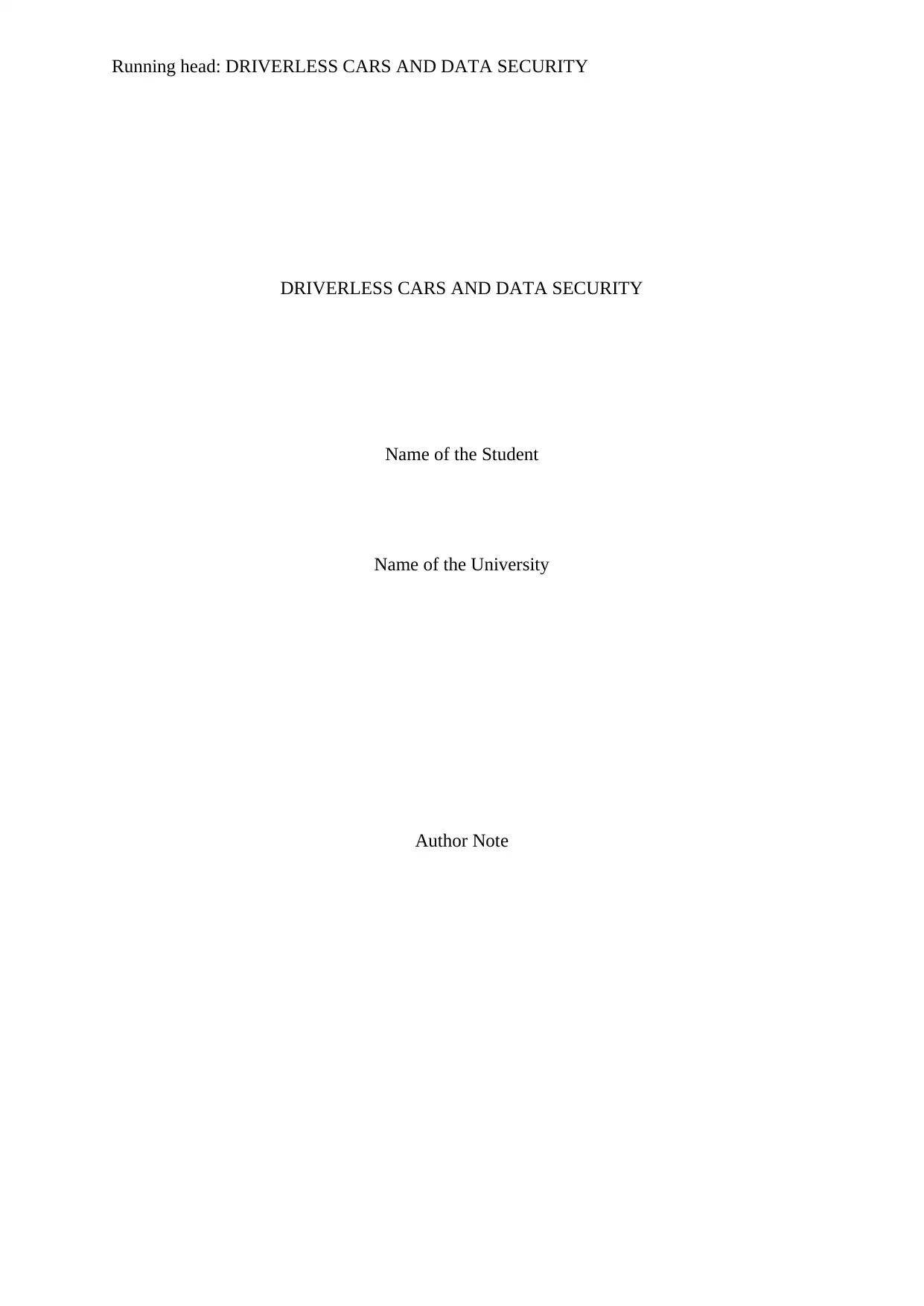
Running head: DRIVERLESS CARS AND DATA SECURITY
DRIVERLESS CARS AND DATA SECURITY
Name of the Student
Name of the University
Author Note
DRIVERLESS CARS AND DATA SECURITY
Name of the Student
Name of the University
Author Note
Paraphrase This Document
Need a fresh take? Get an instant paraphrase of this document with our AI Paraphraser
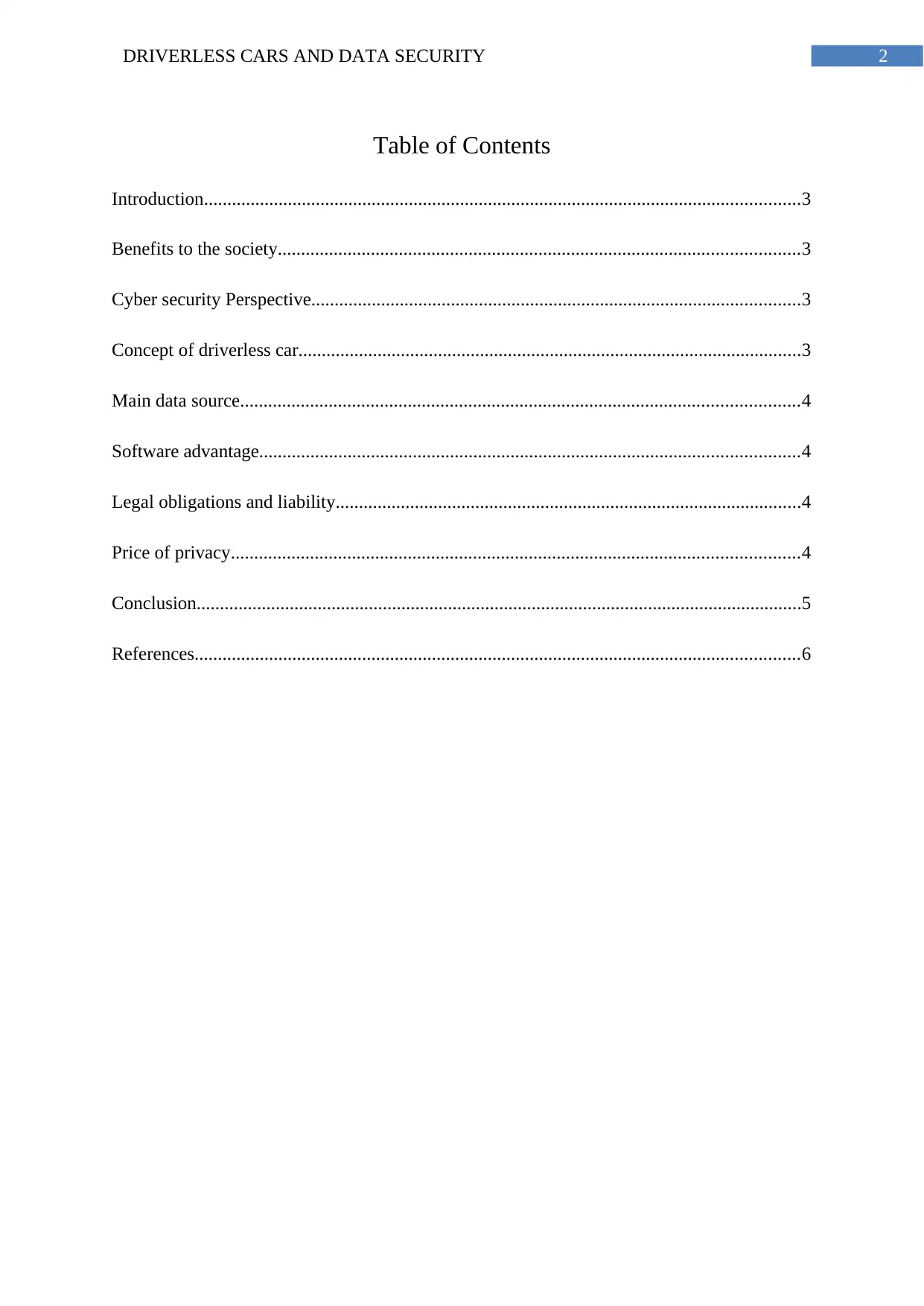
2DRIVERLESS CARS AND DATA SECURITY
Table of Contents
Introduction................................................................................................................................3
Benefits to the society................................................................................................................3
Cyber security Perspective.........................................................................................................3
Concept of driverless car............................................................................................................3
Main data source........................................................................................................................4
Software advantage....................................................................................................................4
Legal obligations and liability....................................................................................................4
Price of privacy..........................................................................................................................4
Conclusion..................................................................................................................................5
References..................................................................................................................................6
Table of Contents
Introduction................................................................................................................................3
Benefits to the society................................................................................................................3
Cyber security Perspective.........................................................................................................3
Concept of driverless car............................................................................................................3
Main data source........................................................................................................................4
Software advantage....................................................................................................................4
Legal obligations and liability....................................................................................................4
Price of privacy..........................................................................................................................4
Conclusion..................................................................................................................................5
References..................................................................................................................................6
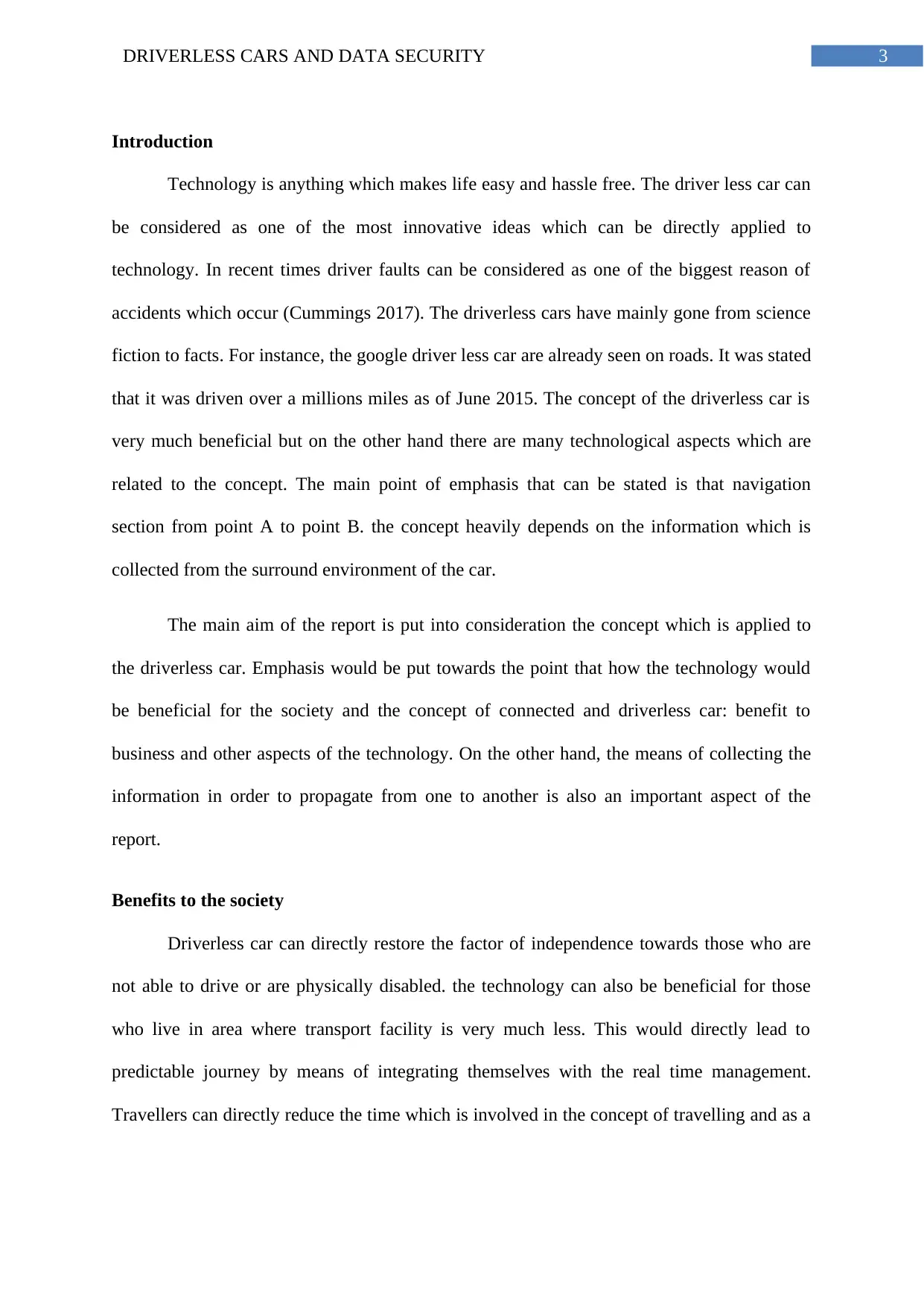
3DRIVERLESS CARS AND DATA SECURITY
Introduction
Technology is anything which makes life easy and hassle free. The driver less car can
be considered as one of the most innovative ideas which can be directly applied to
technology. In recent times driver faults can be considered as one of the biggest reason of
accidents which occur (Cummings 2017). The driverless cars have mainly gone from science
fiction to facts. For instance, the google driver less car are already seen on roads. It was stated
that it was driven over a millions miles as of June 2015. The concept of the driverless car is
very much beneficial but on the other hand there are many technological aspects which are
related to the concept. The main point of emphasis that can be stated is that navigation
section from point A to point B. the concept heavily depends on the information which is
collected from the surround environment of the car.
The main aim of the report is put into consideration the concept which is applied to
the driverless car. Emphasis would be put towards the point that how the technology would
be beneficial for the society and the concept of connected and driverless car: benefit to
business and other aspects of the technology. On the other hand, the means of collecting the
information in order to propagate from one to another is also an important aspect of the
report.
Benefits to the society
Driverless car can directly restore the factor of independence towards those who are
not able to drive or are physically disabled. the technology can also be beneficial for those
who live in area where transport facility is very much less. This would directly lead to
predictable journey by means of integrating themselves with the real time management.
Travellers can directly reduce the time which is involved in the concept of travelling and as a
Introduction
Technology is anything which makes life easy and hassle free. The driver less car can
be considered as one of the most innovative ideas which can be directly applied to
technology. In recent times driver faults can be considered as one of the biggest reason of
accidents which occur (Cummings 2017). The driverless cars have mainly gone from science
fiction to facts. For instance, the google driver less car are already seen on roads. It was stated
that it was driven over a millions miles as of June 2015. The concept of the driverless car is
very much beneficial but on the other hand there are many technological aspects which are
related to the concept. The main point of emphasis that can be stated is that navigation
section from point A to point B. the concept heavily depends on the information which is
collected from the surround environment of the car.
The main aim of the report is put into consideration the concept which is applied to
the driverless car. Emphasis would be put towards the point that how the technology would
be beneficial for the society and the concept of connected and driverless car: benefit to
business and other aspects of the technology. On the other hand, the means of collecting the
information in order to propagate from one to another is also an important aspect of the
report.
Benefits to the society
Driverless car can directly restore the factor of independence towards those who are
not able to drive or are physically disabled. the technology can also be beneficial for those
who live in area where transport facility is very much less. This would directly lead to
predictable journey by means of integrating themselves with the real time management.
Travellers can directly reduce the time which is involved in the concept of travelling and as a
⊘ This is a preview!⊘
Do you want full access?
Subscribe today to unlock all pages.

Trusted by 1+ million students worldwide
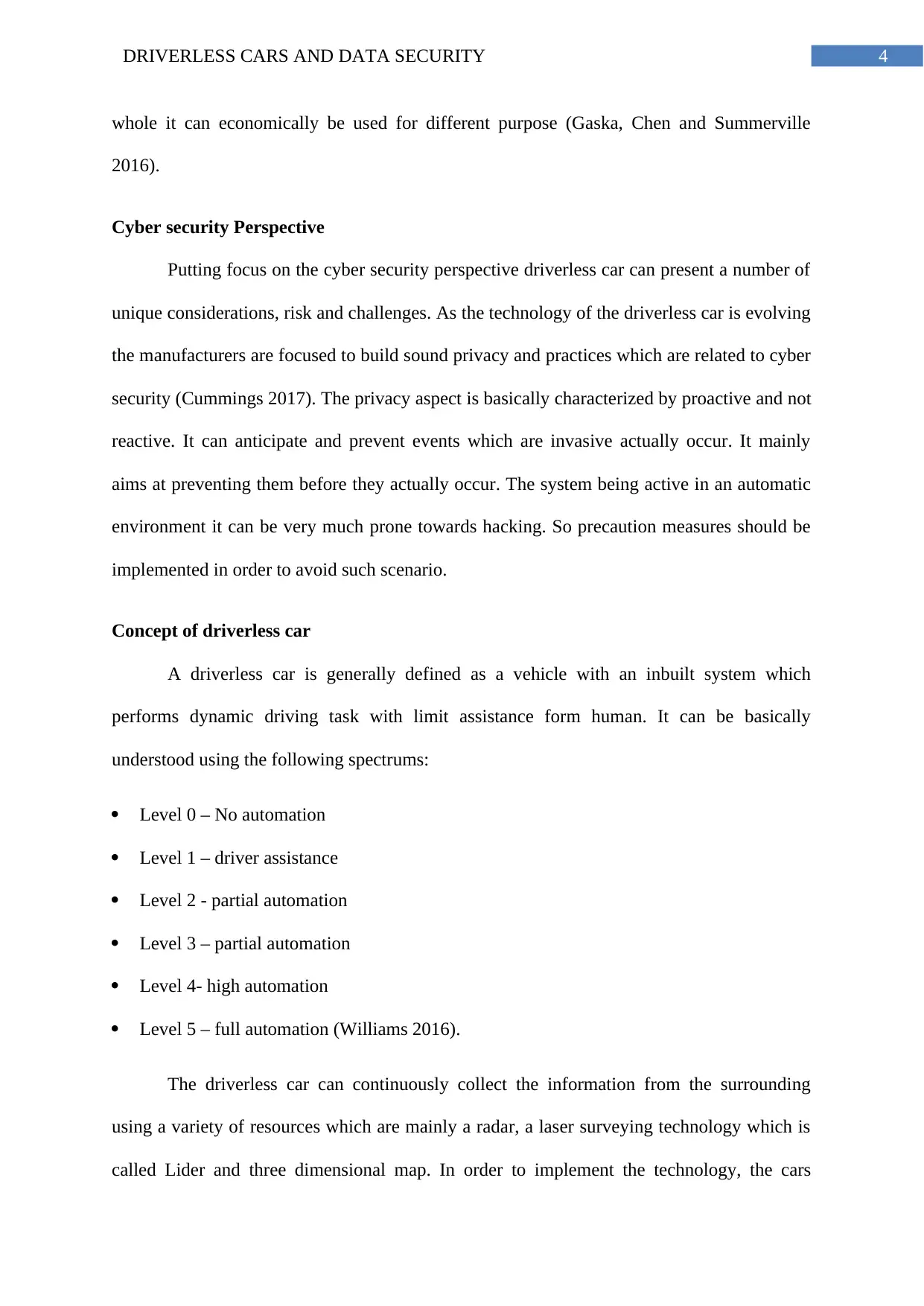
4DRIVERLESS CARS AND DATA SECURITY
whole it can economically be used for different purpose (Gaska, Chen and Summerville
2016).
Cyber security Perspective
Putting focus on the cyber security perspective driverless car can present a number of
unique considerations, risk and challenges. As the technology of the driverless car is evolving
the manufacturers are focused to build sound privacy and practices which are related to cyber
security (Cummings 2017). The privacy aspect is basically characterized by proactive and not
reactive. It can anticipate and prevent events which are invasive actually occur. It mainly
aims at preventing them before they actually occur. The system being active in an automatic
environment it can be very much prone towards hacking. So precaution measures should be
implemented in order to avoid such scenario.
Concept of driverless car
A driverless car is generally defined as a vehicle with an inbuilt system which
performs dynamic driving task with limit assistance form human. It can be basically
understood using the following spectrums:
Level 0 – No automation
Level 1 – driver assistance
Level 2 - partial automation
Level 3 – partial automation
Level 4- high automation
Level 5 – full automation (Williams 2016).
The driverless car can continuously collect the information from the surrounding
using a variety of resources which are mainly a radar, a laser surveying technology which is
called Lider and three dimensional map. In order to implement the technology, the cars
whole it can economically be used for different purpose (Gaska, Chen and Summerville
2016).
Cyber security Perspective
Putting focus on the cyber security perspective driverless car can present a number of
unique considerations, risk and challenges. As the technology of the driverless car is evolving
the manufacturers are focused to build sound privacy and practices which are related to cyber
security (Cummings 2017). The privacy aspect is basically characterized by proactive and not
reactive. It can anticipate and prevent events which are invasive actually occur. It mainly
aims at preventing them before they actually occur. The system being active in an automatic
environment it can be very much prone towards hacking. So precaution measures should be
implemented in order to avoid such scenario.
Concept of driverless car
A driverless car is generally defined as a vehicle with an inbuilt system which
performs dynamic driving task with limit assistance form human. It can be basically
understood using the following spectrums:
Level 0 – No automation
Level 1 – driver assistance
Level 2 - partial automation
Level 3 – partial automation
Level 4- high automation
Level 5 – full automation (Williams 2016).
The driverless car can continuously collect the information from the surrounding
using a variety of resources which are mainly a radar, a laser surveying technology which is
called Lider and three dimensional map. In order to implement the technology, the cars
Paraphrase This Document
Need a fresh take? Get an instant paraphrase of this document with our AI Paraphraser
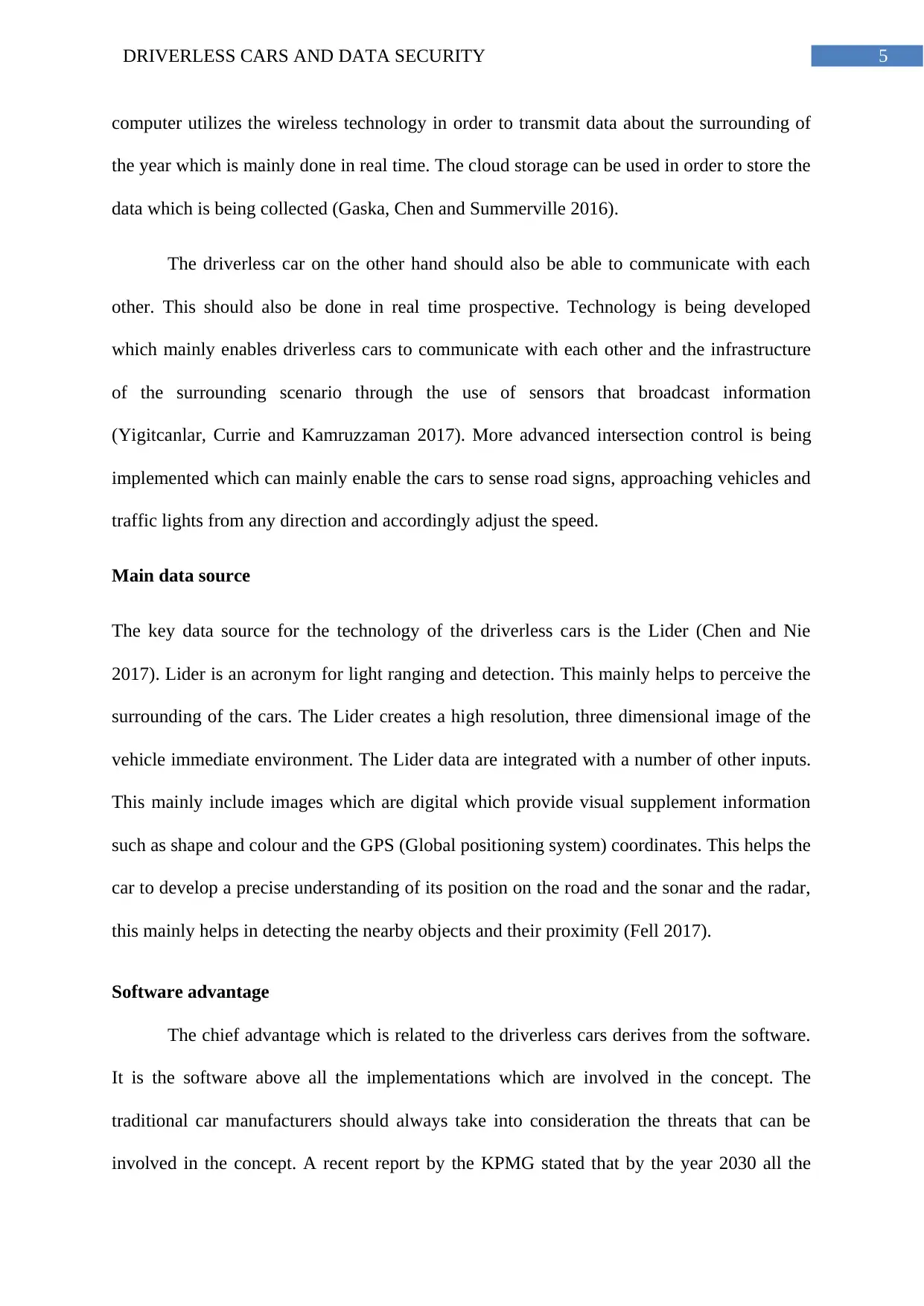
5DRIVERLESS CARS AND DATA SECURITY
computer utilizes the wireless technology in order to transmit data about the surrounding of
the year which is mainly done in real time. The cloud storage can be used in order to store the
data which is being collected (Gaska, Chen and Summerville 2016).
The driverless car on the other hand should also be able to communicate with each
other. This should also be done in real time prospective. Technology is being developed
which mainly enables driverless cars to communicate with each other and the infrastructure
of the surrounding scenario through the use of sensors that broadcast information
(Yigitcanlar, Currie and Kamruzzaman 2017). More advanced intersection control is being
implemented which can mainly enable the cars to sense road signs, approaching vehicles and
traffic lights from any direction and accordingly adjust the speed.
Main data source
The key data source for the technology of the driverless cars is the Lider (Chen and Nie
2017). Lider is an acronym for light ranging and detection. This mainly helps to perceive the
surrounding of the cars. The Lider creates a high resolution, three dimensional image of the
vehicle immediate environment. The Lider data are integrated with a number of other inputs.
This mainly include images which are digital which provide visual supplement information
such as shape and colour and the GPS (Global positioning system) coordinates. This helps the
car to develop a precise understanding of its position on the road and the sonar and the radar,
this mainly helps in detecting the nearby objects and their proximity (Fell 2017).
Software advantage
The chief advantage which is related to the driverless cars derives from the software.
It is the software above all the implementations which are involved in the concept. The
traditional car manufacturers should always take into consideration the threats that can be
involved in the concept. A recent report by the KPMG stated that by the year 2030 all the
computer utilizes the wireless technology in order to transmit data about the surrounding of
the year which is mainly done in real time. The cloud storage can be used in order to store the
data which is being collected (Gaska, Chen and Summerville 2016).
The driverless car on the other hand should also be able to communicate with each
other. This should also be done in real time prospective. Technology is being developed
which mainly enables driverless cars to communicate with each other and the infrastructure
of the surrounding scenario through the use of sensors that broadcast information
(Yigitcanlar, Currie and Kamruzzaman 2017). More advanced intersection control is being
implemented which can mainly enable the cars to sense road signs, approaching vehicles and
traffic lights from any direction and accordingly adjust the speed.
Main data source
The key data source for the technology of the driverless cars is the Lider (Chen and Nie
2017). Lider is an acronym for light ranging and detection. This mainly helps to perceive the
surrounding of the cars. The Lider creates a high resolution, three dimensional image of the
vehicle immediate environment. The Lider data are integrated with a number of other inputs.
This mainly include images which are digital which provide visual supplement information
such as shape and colour and the GPS (Global positioning system) coordinates. This helps the
car to develop a precise understanding of its position on the road and the sonar and the radar,
this mainly helps in detecting the nearby objects and their proximity (Fell 2017).
Software advantage
The chief advantage which is related to the driverless cars derives from the software.
It is the software above all the implementations which are involved in the concept. The
traditional car manufacturers should always take into consideration the threats that can be
involved in the concept. A recent report by the KPMG stated that by the year 2030 all the
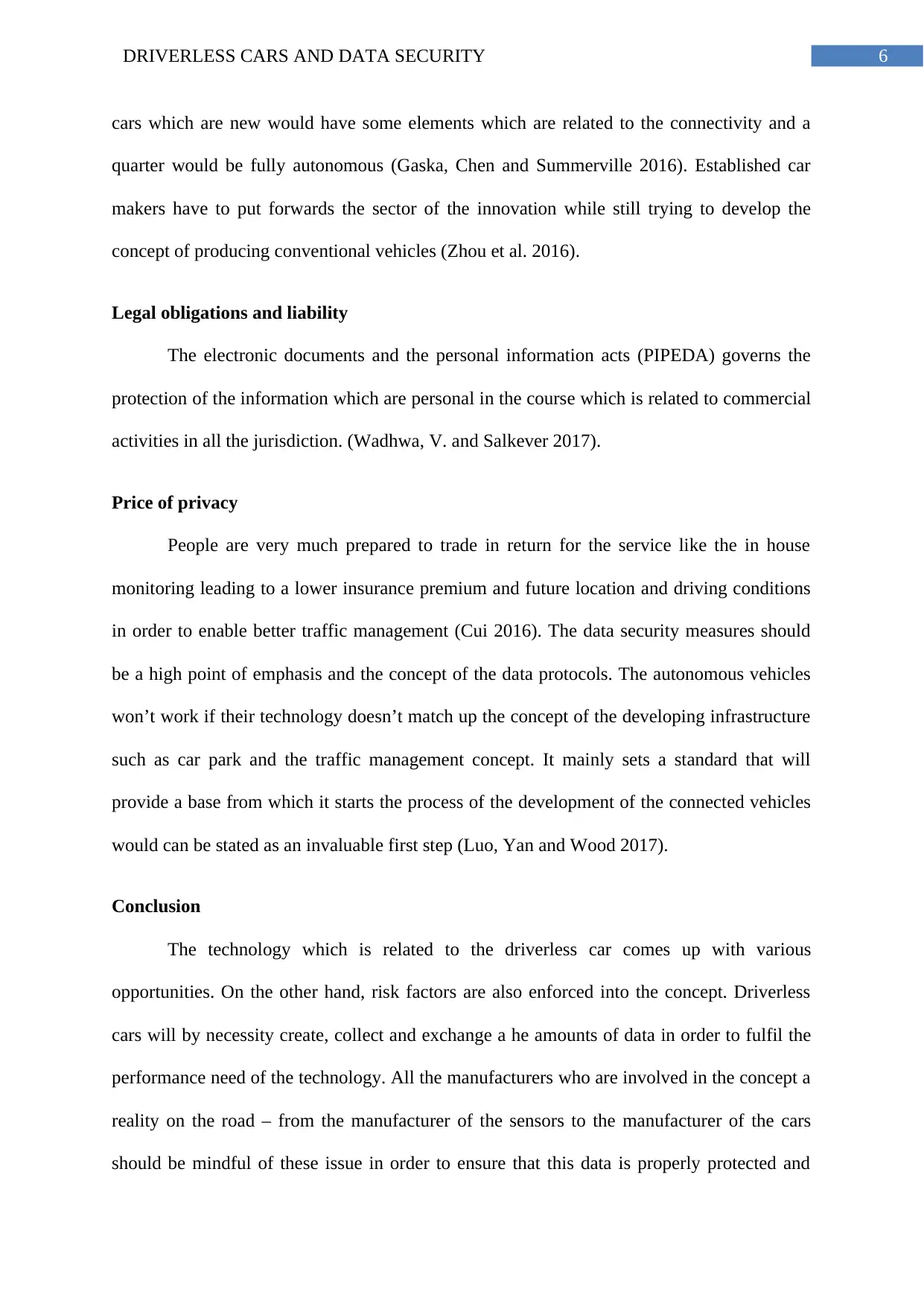
6DRIVERLESS CARS AND DATA SECURITY
cars which are new would have some elements which are related to the connectivity and a
quarter would be fully autonomous (Gaska, Chen and Summerville 2016). Established car
makers have to put forwards the sector of the innovation while still trying to develop the
concept of producing conventional vehicles (Zhou et al. 2016).
Legal obligations and liability
The electronic documents and the personal information acts (PIPEDA) governs the
protection of the information which are personal in the course which is related to commercial
activities in all the jurisdiction. (Wadhwa, V. and Salkever 2017).
Price of privacy
People are very much prepared to trade in return for the service like the in house
monitoring leading to a lower insurance premium and future location and driving conditions
in order to enable better traffic management (Cui 2016). The data security measures should
be a high point of emphasis and the concept of the data protocols. The autonomous vehicles
won’t work if their technology doesn’t match up the concept of the developing infrastructure
such as car park and the traffic management concept. It mainly sets a standard that will
provide a base from which it starts the process of the development of the connected vehicles
would can be stated as an invaluable first step (Luo, Yan and Wood 2017).
Conclusion
The technology which is related to the driverless car comes up with various
opportunities. On the other hand, risk factors are also enforced into the concept. Driverless
cars will by necessity create, collect and exchange a he amounts of data in order to fulfil the
performance need of the technology. All the manufacturers who are involved in the concept a
reality on the road – from the manufacturer of the sensors to the manufacturer of the cars
should be mindful of these issue in order to ensure that this data is properly protected and
cars which are new would have some elements which are related to the connectivity and a
quarter would be fully autonomous (Gaska, Chen and Summerville 2016). Established car
makers have to put forwards the sector of the innovation while still trying to develop the
concept of producing conventional vehicles (Zhou et al. 2016).
Legal obligations and liability
The electronic documents and the personal information acts (PIPEDA) governs the
protection of the information which are personal in the course which is related to commercial
activities in all the jurisdiction. (Wadhwa, V. and Salkever 2017).
Price of privacy
People are very much prepared to trade in return for the service like the in house
monitoring leading to a lower insurance premium and future location and driving conditions
in order to enable better traffic management (Cui 2016). The data security measures should
be a high point of emphasis and the concept of the data protocols. The autonomous vehicles
won’t work if their technology doesn’t match up the concept of the developing infrastructure
such as car park and the traffic management concept. It mainly sets a standard that will
provide a base from which it starts the process of the development of the connected vehicles
would can be stated as an invaluable first step (Luo, Yan and Wood 2017).
Conclusion
The technology which is related to the driverless car comes up with various
opportunities. On the other hand, risk factors are also enforced into the concept. Driverless
cars will by necessity create, collect and exchange a he amounts of data in order to fulfil the
performance need of the technology. All the manufacturers who are involved in the concept a
reality on the road – from the manufacturer of the sensors to the manufacturer of the cars
should be mindful of these issue in order to ensure that this data is properly protected and
⊘ This is a preview!⊘
Do you want full access?
Subscribe today to unlock all pages.

Trusted by 1+ million students worldwide
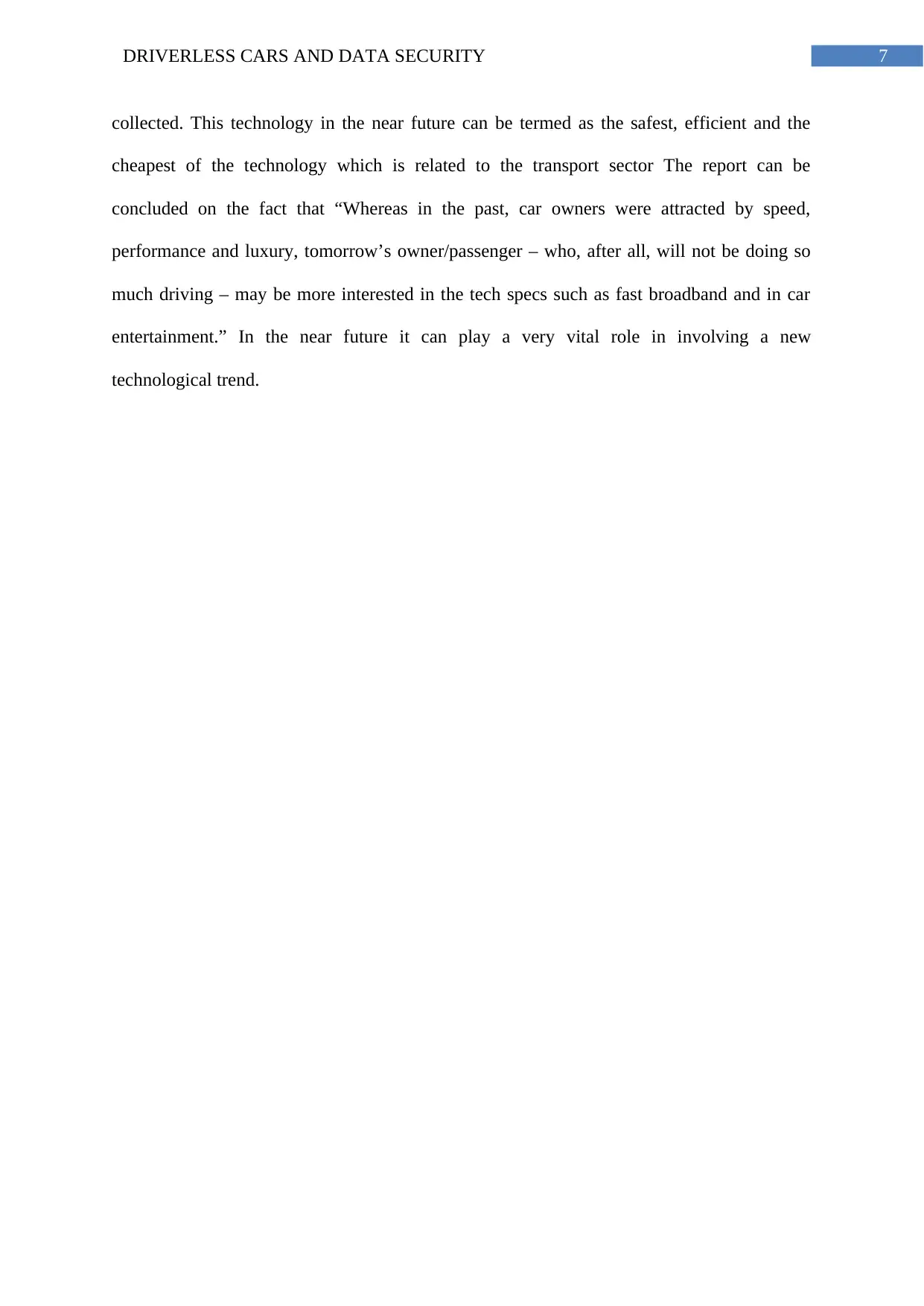
7DRIVERLESS CARS AND DATA SECURITY
collected. This technology in the near future can be termed as the safest, efficient and the
cheapest of the technology which is related to the transport sector The report can be
concluded on the fact that “Whereas in the past, car owners were attracted by speed,
performance and luxury, tomorrow’s owner/passenger – who, after all, will not be doing so
much driving – may be more interested in the tech specs such as fast broadband and in car
entertainment.” In the near future it can play a very vital role in involving a new
technological trend.
collected. This technology in the near future can be termed as the safest, efficient and the
cheapest of the technology which is related to the transport sector The report can be
concluded on the fact that “Whereas in the past, car owners were attracted by speed,
performance and luxury, tomorrow’s owner/passenger – who, after all, will not be doing so
much driving – may be more interested in the tech specs such as fast broadband and in car
entertainment.” In the near future it can play a very vital role in involving a new
technological trend.
Paraphrase This Document
Need a fresh take? Get an instant paraphrase of this document with our AI Paraphraser
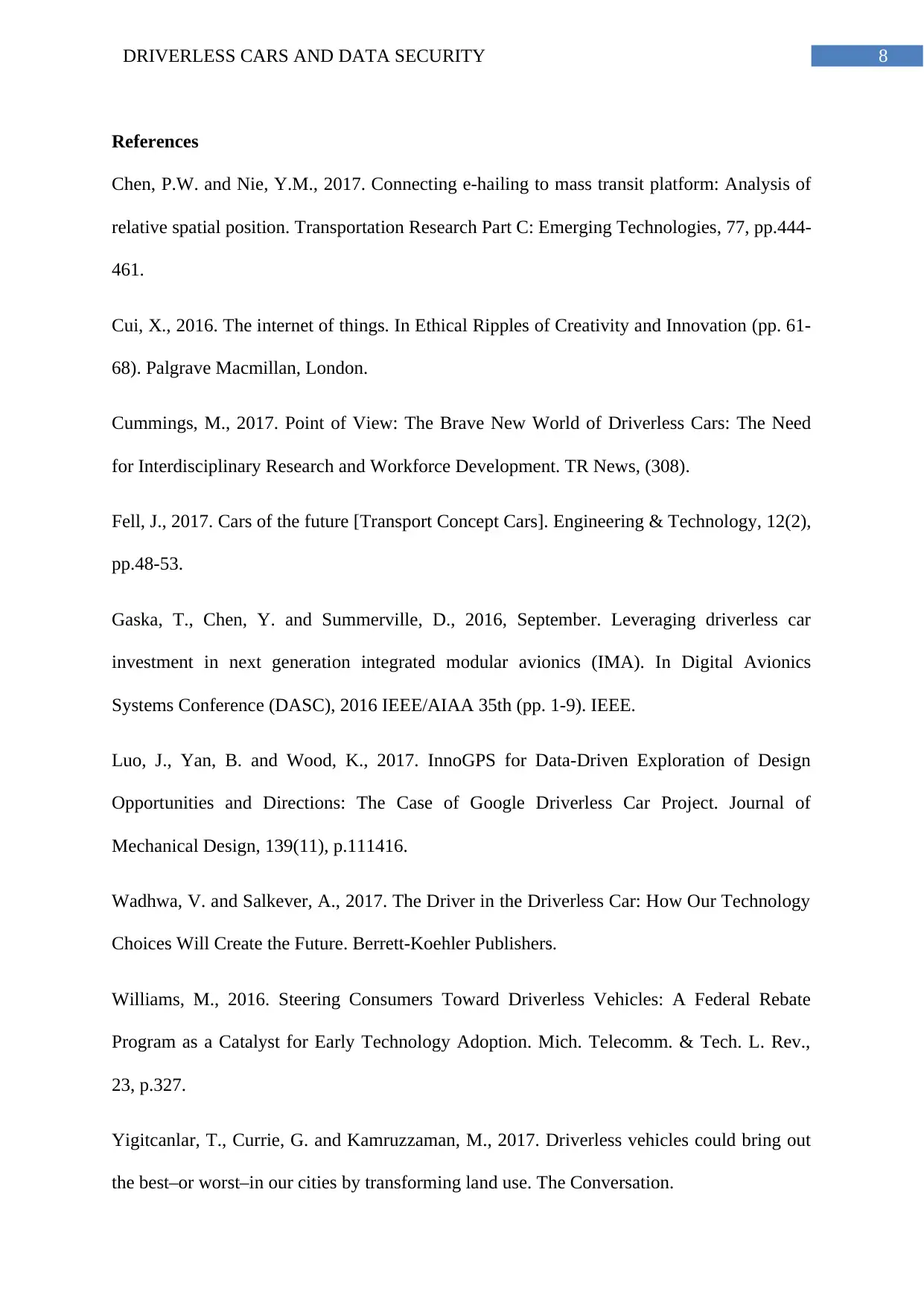
8DRIVERLESS CARS AND DATA SECURITY
References
Chen, P.W. and Nie, Y.M., 2017. Connecting e-hailing to mass transit platform: Analysis of
relative spatial position. Transportation Research Part C: Emerging Technologies, 77, pp.444-
461.
Cui, X., 2016. The internet of things. In Ethical Ripples of Creativity and Innovation (pp. 61-
68). Palgrave Macmillan, London.
Cummings, M., 2017. Point of View: The Brave New World of Driverless Cars: The Need
for Interdisciplinary Research and Workforce Development. TR News, (308).
Fell, J., 2017. Cars of the future [Transport Concept Cars]. Engineering & Technology, 12(2),
pp.48-53.
Gaska, T., Chen, Y. and Summerville, D., 2016, September. Leveraging driverless car
investment in next generation integrated modular avionics (IMA). In Digital Avionics
Systems Conference (DASC), 2016 IEEE/AIAA 35th (pp. 1-9). IEEE.
Luo, J., Yan, B. and Wood, K., 2017. InnoGPS for Data-Driven Exploration of Design
Opportunities and Directions: The Case of Google Driverless Car Project. Journal of
Mechanical Design, 139(11), p.111416.
Wadhwa, V. and Salkever, A., 2017. The Driver in the Driverless Car: How Our Technology
Choices Will Create the Future. Berrett-Koehler Publishers.
Williams, M., 2016. Steering Consumers Toward Driverless Vehicles: A Federal Rebate
Program as a Catalyst for Early Technology Adoption. Mich. Telecomm. & Tech. L. Rev.,
23, p.327.
Yigitcanlar, T., Currie, G. and Kamruzzaman, M., 2017. Driverless vehicles could bring out
the best–or worst–in our cities by transforming land use. The Conversation.
References
Chen, P.W. and Nie, Y.M., 2017. Connecting e-hailing to mass transit platform: Analysis of
relative spatial position. Transportation Research Part C: Emerging Technologies, 77, pp.444-
461.
Cui, X., 2016. The internet of things. In Ethical Ripples of Creativity and Innovation (pp. 61-
68). Palgrave Macmillan, London.
Cummings, M., 2017. Point of View: The Brave New World of Driverless Cars: The Need
for Interdisciplinary Research and Workforce Development. TR News, (308).
Fell, J., 2017. Cars of the future [Transport Concept Cars]. Engineering & Technology, 12(2),
pp.48-53.
Gaska, T., Chen, Y. and Summerville, D., 2016, September. Leveraging driverless car
investment in next generation integrated modular avionics (IMA). In Digital Avionics
Systems Conference (DASC), 2016 IEEE/AIAA 35th (pp. 1-9). IEEE.
Luo, J., Yan, B. and Wood, K., 2017. InnoGPS for Data-Driven Exploration of Design
Opportunities and Directions: The Case of Google Driverless Car Project. Journal of
Mechanical Design, 139(11), p.111416.
Wadhwa, V. and Salkever, A., 2017. The Driver in the Driverless Car: How Our Technology
Choices Will Create the Future. Berrett-Koehler Publishers.
Williams, M., 2016. Steering Consumers Toward Driverless Vehicles: A Federal Rebate
Program as a Catalyst for Early Technology Adoption. Mich. Telecomm. & Tech. L. Rev.,
23, p.327.
Yigitcanlar, T., Currie, G. and Kamruzzaman, M., 2017. Driverless vehicles could bring out
the best–or worst–in our cities by transforming land use. The Conversation.

9DRIVERLESS CARS AND DATA SECURITY
Zhou, K., Yu, L., Long, Z. and Mo, S., 2017. Local Path Planning of Driverless Car
Navigation Based on Jump Point Search Method Under Urban Environment. Future Internet,
9(3), p.51.
Zhou, K., Yu, L., Long, Z. and Mo, S., 2017. Local Path Planning of Driverless Car
Navigation Based on Jump Point Search Method Under Urban Environment. Future Internet,
9(3), p.51.
⊘ This is a preview!⊘
Do you want full access?
Subscribe today to unlock all pages.

Trusted by 1+ million students worldwide
1 out of 9
Related Documents
Your All-in-One AI-Powered Toolkit for Academic Success.
+13062052269
info@desklib.com
Available 24*7 on WhatsApp / Email
![[object Object]](/_next/static/media/star-bottom.7253800d.svg)
Unlock your academic potential
Copyright © 2020–2025 A2Z Services. All Rights Reserved. Developed and managed by ZUCOL.





